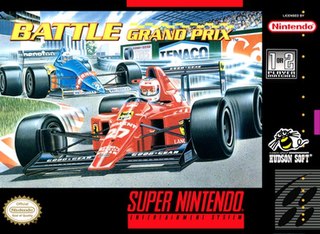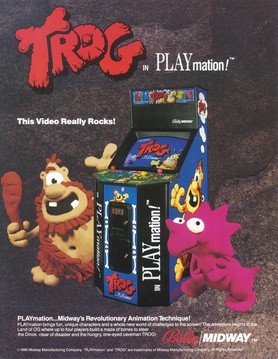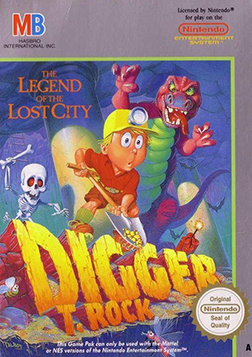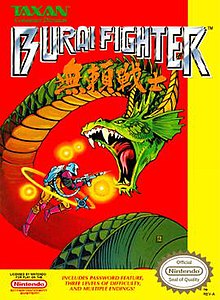
Snake Rattle 'n' Roll is a platform video game developed by Rare. It was published by Nintendo and released for the Nintendo Entertainment System in North America in July 1990 and in Europe on March 27, 1991. The game features two snakes, Rattle and Roll, as they make their way through eleven 3D isometric levels. A Mega Drive version was released by Sega in June 1993 with an extra level. Snake Rattle 'n' Roll was developed by Rare members Tim Stamper and Mark Betteridge. The music was composed by David Wise and was inspired by "Shake, Rattle and Roll" and other 1950s-era songs.

Little Nemo: The Dream Master is a platform game released on the NES in 1990 by Capcom. It is based on the Japanese animated film, Little Nemo: Adventures in Slumberland from Tokyo Movie Shinsha, which itself is based on the comic strip Little Nemo in Slumberland by Winsor McCay. The game's music was composed by Junko Tamiya, credited in the game as "Gonzou".

Batman: Return of the Joker is a 1991 platform video game, the follow-up to Sunsoft's first Batman game on the Nintendo Entertainment System. Unlike that game, which was based on the 1989 Batman film directed by Tim Burton, Return of the Joker is entirely self-contained and based more on the modern comic book iteration of Batman, but the Batmobile and the Batwing are featured from the 1989 film. A remake of Return of the Joker, titled Batman: Revenge of the Joker, was released on the Sega Genesis by Ringler Studios in 1992. A Super NES version of Revenge of the Joker was completed but never officially released; a ROM image surfaced online in later years.

G.I. Joe: A Real American Hero is a 1991 run and gun game published by Taxan for the Nintendo Entertainment System based on the toyline of the same name. The game was produced by Ken Lobb and developed by the same Japanese team that later formed KID. A sequel developed by the same team, titled G.I. Joe: The Atlantis Factor, was released the following year, but was published by Capcom after Taxan went out of business.

Total Carnage is a multidirectional shooter arcade video game originally developed and published by Midway in North America in January 1992. Set in the fictional country of Kookistan during 1999, players assume the role of Captain Carnage and Major Mayhem from the Doomsday Squad in a last-ditch effort to overthrow dictator General Akhboob and his army of mutants from conquering the world, while also rescuing POWs held by his military force.

Super Ghouls 'n Ghosts, known as Chou Makaimura in Japan, is a platform video game developed and published by Capcom for the Super Nintendo Entertainment System in 1991. As the third game in the Ghosts 'n Goblins series and the first not to be released for the arcade, it again depicts knight Arthur saving Princess Guinevere and the kingdom from Emperor Sardius, who has cast a spell that has revived the Ghoul Realm.

Low G Man: The Low Gravity Man is a platform game developed by KID and published in 1990 by Taxan in North America and by Nintendo in Europe for the Nintendo Entertainment System.

D-Force is a 1991 vertical scrolling shooter video game developed and published in Japan by Asmik for the Super Famicom and later localized and published in North America by Asmik Corporation of America for the Super NES. It involves an Apache helicopter set on defeating an evil Middle Eastern dictator. There are seven levels which feature six countries. Some of the levels involve switching altitudes in order to attack enemies from a different height, which uses Mode 7, one of the main features of the Super NES.

Konami Hyper Soccer is a 1992 soccer video game developed and published by Konami in Europe and Mattel in Australia for the Nintendo Entertainment System. Part of the Hyper Sports series, which included Hyper Olympic, its sequel Hyper Sports and Hyper Athlete, it is the second soccer game by Konami following Konami's Soccer on the MSX, and their first soccer game on a Nintendo platform.

Battle Grand Prix is a 1992 Formula One racing video game developed by KID. One or two players can pit themselves in three Grand Prix races. Each of the different team cars have different color schemes. The courses vary from blacktop to concrete, and rain is also included and is implemented in the game.

Last Resort is a horizontally scrolling shooter by SNK released as an arcade video game in 1992. It was also released for the Neo-Geo and Neo Geo CD systems, SNK Arcade Classics Vol. 1 for the PlayStation 2, PlayStation Portable, and Wii, as well as ACA Neo-Geo for the PlayStation 4 and Xbox One.

Trog is a maze arcade video game developed and published by Midway Manufacturing in 1990 in North America under the "Bally/Midway" label and later by Williams Electronics in Europe. In the game, players control one of four dinosaurs chased by the titular cavemen. Its gameplay includes elements of Pac-Man—collect all items in a maze, eat a special item to turn the tables on pursuers—but supports up to four players at once. Initially envisioned as a hybrid puzzle/strategy project, its original concept was later reworked into a Pac-Man-like title after poor reception from testers and features claymation graphics, advertised as "Playmation" by Midway. Conversions for the Nintendo Entertainment System and MS-DOS were released by Acclaim Entertainment in 1990 and 1991 respectively, reducing the number of simultaneous players to two. Both the arcade and NES versions garnered positive reception from critics.

Digger T. Rock: Legend of the Lost City is a platform game developed by Rare and published by the Milton Bradley Company for the Nintendo Entertainment System. It was first released in North America in December 1990 and in Europe in 1991. The game centres around the miner Digger T. Rock, as he spelunks various caves and catacombs whilst searching for the mythical Lost City.

Isolated Warrior is a 1991 video game developed by KID and published in Japan by Vap, in North America by NTVIC, and Europe by Nintendo.

Batman: The Video Game is a platform game developed by Sunsoft for the Nintendo Entertainment System, loosely based on the 1989 film Batman. The game contains five levels culminating in a showdown with the Joker in the bell tower of Gotham Cathedral. It was received well.

Cyber Core is a 1990 vertically scrolling shooter video game developed by Alfa System and published in Japan by Information Global Service (IGS) and in North America by NEC for the TurboGrafx-16. Set in the year 2269 where Earth has been overrun by an alien race known as Hyper Insects, the player controls a Chimera bio-fighter craft, piloted by the enforcer Rad Ralph in order to fend off the invaders and reclaim the planet. Similar to Dragon Spirit, Ralph has a projectile weapon for destroying air-based enemies and a bomb for destroying ground-based enemies.

Top Gun is a shoot 'em up combat flight simulation game based on the 1986 hit film Top Gun. It was developed and published by Konami for the Nintendo Entertainment System. It was released in the United States and Canada in November 1987, and then in Europe. It is an adaptation of VS. Top Gun, a 1987 Nintendo VS. System arcade game also by Konami. As the second game to establish the Top Gun game series, it was followed by Top Gun: The Second Mission. It is known for its extremely high difficulty.

P-47: The Phantom Fighter is a 1988 horizontally scrolling shooter arcade video game originally developed by NMK and published by Jaleco. Set during World War II, players control a Republic P-47 Thunderbolt fighter aircraft to face against the Nazis, who are occupying multiple countries around the world. Its gameplay involves destroying waves of enemies, picking up power-ups and new weapons, and destroying bosses. It ran on the Mega System 1 hardware.

Trax is a shooter game for Nintendo's Game Boy developed by HAL Laboratory and published by HAL Laboratory in Japan and Electro Brain in other regions. It was released on January 8, 1991, in Japan and released in September 1, 1991 overseas.

Batman: The Video Game is a 1990 action video game developed and published by Sunsoft for the Game Boy. Based on the DC Comics superhero Batman, it is inspired by the Warner Bros.'s 1989 film of the same name. In the main storyline, Batman must face the Joker. The Game Boy version was developed by most of the same staff at Sunsoft which had previously worked on the Nintendo Entertainment System adaptation based on the 1989 film. It was produced by Cho Musou, while soundtrack was composed by Naoki Kodaka, Nobuyuki Hara, and Shinichi Seya. The game garnered generally favorable reception from critics and retrospective commentarists.




















